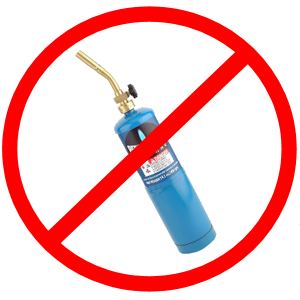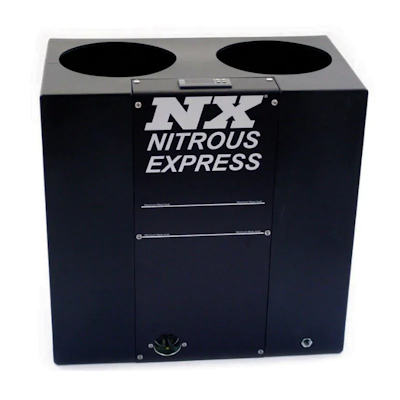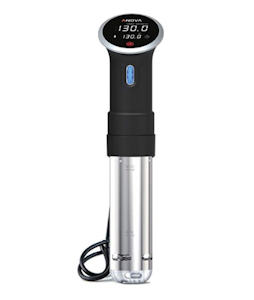Kiss that Torch Good Bye with Nitrous Bottle Heaters!
Get those bottles up to pressure the safe way...

Friends don't let friends torch bottles!
To get peak performance from your nitrous system it's a well known fact that nitrous bottle pressure plays an important role. If your bottle pressure is too low, your nitrous system tune up will be pig fat and have less than desired results. Too much bottle pressure and you may be getting into a lean tune up, unable to activate the nitrous solenoids, or in a worst case situation run into safety issues with the bottle itself. Most nitrous companies recommend a nitrous bottle pressure around 900-950 PSI, and many racers run upwards of 1000 PSI depending on the volume they are using and other factors . The tricky part is getting that bottle up to the correct pressure and maintaining it there for during the run. Ideally you want to avoid your nitrous pressure droppping below 750-800psi during a pass to avoid the liquid nitrous turning to a gas.
| Nitrous Bottle Pressure Vs. Nitrous Bottle Temperature | |
|---|---|
| Temp °F | PSI |
|
|
|
|
|
|
|
|
|
|
|
|
|
|
|
|
|
|
|
|
|
|
|
|
|
|
|
|
|
|
|
|
|
|
|
|
| WARNING! EXPOSURE TO TEMPERATURES IN EXCESS OF 130° F MAY CAUSE AN EXPLOSIVE FAILURE | |
| Get a Large Version of this Chart | |
Take a minute and study the Pressure Vs. Temperature chart on the right side of the page. As you can see if you're going to be racing in 60 or 70 degree weather you're going to be way low on bottle pressure. If you're racing in the heat of the summer, you'll need to be cooling the bottle down to get it to the recommended manufacturer's pressures.
“Critical pressure” is the minimum pressure required to liquefy a gas up to its “critical temperature.” Our research has found that above 97.7F (1069 psi) , nitrous oxide does not remain liquid. The world of science accepts the fact that: “The critical temperature is defined as that temperature above which a gas can no longer remain liquid, regardless of the pressure applied.”
Ricky Dyer of O2-Technology
Ricky also states that above 102°F Nitrous is 100% gas. This has a big effect on your tune up as the difference between gaseous and liquid nitrous affects how much you're putting in your engine! On the low pressure side, you want to stay above 760 psi to maintain Nitrous as a liquid, lower than that and it starts to turn into a gas again.
It's easy to cool a bottle down, just soak a towel in your cooler and lay it on the bottle and it will bring the temperature down quickly. Heating up the bottle is a bit more controversial subject, let's take a look at the methods people use to heat up their bottles...
Heating Bottles with a Propane Torch
Even though heating bottles with a propane torch is a popular method among some racers, it's dangerous and can get people hurt.
Aluminum starts to melt around 800 degrees and applying that much heat for too long in any one spot can weaken the bottle causing it to rupture. Think!!! We're talking about an aluminum (which melts easily) nitrous bottle filled with an oxidizer at high pressures and applying a torch (filled with fuel) to it - not a wise idea. Don't even consider using a torch on a carbon fiber bottle.
There are more reasons, besides the obvious safety issues, to not use a torch to heat your bottles. Many tracks have outlawed this practice and some sanctioning bodies such as IHRA, AMA/Pro-Star have as outlawed it as well. Finally, those telltale scorch marks on a bottle may also prevent you from getting the bottle refilled at many locations, and you'll likely have a problem selling the bottle in that condition as well!
Wrap Around Electric Nitrous Bottle Heaters
One of the most common ways to heat a bottle is to use a wrap around style electric bottle heater. Most of these heaters are powered by the cars 12 volt power system. The good systems utilize either a thermostat or pressure switch to turn the heater on and off. A heater without a pressure switch or thermostat can be a safety risk because the pressure will keep climbing to unsafe levels if the heater isn't turned off at a safe level. Even with a thermostatically or pressure switch controlled heater, it's a good idea to keep an eye on the bottle pressure during the heating process.
Even a 400 watt heater can take quite a while to bring a bottle up to racing temperatures in cool weather. If you're racing on a cool day, say 64 °F (700 PSI) and want to bring your bottle up to say 88 °F (900 PSI), you're looking at right around 18-20 minutes minimum to get it there. With this short amount of heating time, the bottle isn't going to be evenly heated either, we'll talk about that further in this article.
The other drawback to most nitrous bottle heaters is they run on 12 volt DC current and draw a lot of amps which can run your battery down quickly when trying to heat a cold bottle. The folks at Applied Racing Components have a great solution for that problem with their combo 12 volt DC / 110 volt AC Nitrous Bottle heater.
This $175* combination model is hot because you can get your bottle fully up to temperature by just plugging it into your generator without draining your battery. If you have to sit in the staging lanes for an extended time you can also use the 12 volt heater to keep the bottle at pressure. Getting the bottle up to temperature is the hard part, keeping it there is far easier for the heater to do. Most DC bottle heaters are rated around 240 watts, while not as fast as a 110 volt model, they will do an adequate job of heating a bottle in warmer weather.
Our experience with small pressure switches to control these heaters hasn't been that great. The small switches have to much hysteresis and just can not maintain a very close temperature range. We just manually cycle the heater on and off while using the in car pressure gauge. We do not leave these bottle heaters on while not being attended!
Many Nitrous racers use these style of heaters in conjunction with a Water Bath Heater. The Electric heater is primarily used to bump up pressure in the staging lanes if they have to sit for long, especially in cold weather. Nitrous Express Hot Water Bottle Heater
Nitrous Express Hot Water Bottle Heater
Nitrous Bottle Water Heaters
Almost all serious nitrous racers use heated water tanks to keep bottles at the exact "Ready to Race" pressure so at least two bottles are ready to go when they get the call to the lanes. There are several different styles of 110 AC multi-bottle water heaters available from different sources, however the quality of the control systems will vary and that is very important to maintain tight bottle temperatures.
One of the best water bath style Nitrous Bottle Heaters in the industry is the one made by Nitrous Express which maintains the water temperature very tightly, which is quite important. Many of this style are made of fabricated aluminum, however the NX model is actually molded plastic which adds a few benefits. For one, no corrosion, but even more important the plastic insulates the tank better requiring less power needed to maintain temperatures.
The biggest advantage to the water tank style heaters is very uniform bottle heating and the ability to heat soak the entire contents of the bottle, they are a must-have for the serious nitrous Racer.
Home Made Bottle Heaters
 Sous Vide Hot Water Heater
Sous Vide Hot Water Heater
Some racers have had good luck with the Sous Vide pressure cooker water heater, they just drop this on the side of a bucket or cooler. It's an 800 watt 120 volt temperature controlled heater that even circulates the water. Since it's about 1/2 the wattage of the NX heater above, it will take a while longer to bring the water up to temp, it is low cost and we hear it's reasonable accurate on maintaining temperatures. Not a bad idea for a quick solution for heating your bottle/s, sure it's not as nice as the NX heater, but it will get the job done. You can get these Sous Vide Heaters on Amazon for around $125.
If you're building your own homemade bottle heater using a water heater element, the one most people use is a TG1153L 430342 1500 Watt Element, this is the 4 bolt square flange model that most fabricated bottle heaters use.
This article on home made nitrous bottle heaters may be useful as well for more information on heaters and controllers. Good discussion on temperature controls and what to watch out for when building your own system.
Safety First
If you use a heater with a pressure switch located on the bottle outlet (same line that goes to your engine), you must be aware that the pressure switch will not see the actual bottle pressure if the bottle valve is closed. This will cause the heater to not shut off at the appropriate pressure. It will just keep on building pressure till the safety disc in the bottle ruptures or the bottle explodes.
If you're bottle valve has a port on the bottle side of the valve, that's a much better location for the switch because it will be able to see the bottle pressure regardless of if the valve is open or not. It isn't as handy since you'll have to unhook the switch when removing the bottle but it is much safer if you forget and leave the heater on.
When heating a nitrous bottle always keep safety in mind. Nitrous bottles are normally equipped with a safety burst disc in the bottle valve to prevent over pressurization of the bottle, However it is possible that the disc may not open as planned which could lead to a bottle explosion. It's a real good idea not to fully rely on automatic thermostats or pressure switches to regulate your bottle pressure. When heating your bottle, manually monitor the nitrous pressure or the tank temperature and don't leave bottles heating unattended.
Fundamentals of Nitrous Bottle Heating
Heating up a bottle takes time, the chart below shows how long it takes to get a 15lb bottle heated up to 1200 PSI from 64 degrees. An important point is EVEN heating of the nitrous, you can get the pressure up to 1000 PSI fairly quickly with most heaters, but it will quickly fall when you remove the heating element because the entire nitrous volume is not yet at an even temperature. To do that, you need to heat soak the bottle for an extended period of time.
*Please note that this test was conducted with a good bottle heater that puts out 400watts BUT it used a thermostat to switch it on and off. That thermostat, due to hysteresis (the differential between when the thermostat opens and closes), increased the time to heat up the bottle because the blanket was not on constantly. I have not tested the same heater with a pressure switch style setup yet, but you should find that pressure switch controlled heaters are considerably faster than thermostatically controlled heaters because the element stays on until the pressure is reached. Unlike a thermostat style which cycles on and off as it heats. That said, because the bottle heats up quicker with a pressure switch control, you still have the issue of how long it takes to heat soak all the nitrous in the bottle.

In the chart above it took us only 15 some minutes to get the nitrous up to 1000 PSI (99°F), but at the bottom of the bottle it was 13 degrees cooler than at the top half of the bottle. This indicates that the bottle isn't fully heat soaked. Removing the heater at this point would cause the bottle temp to quickly drop. Bottle blankets do help to reduce this, but to keep your pressure up during the run it helps a lot to have the entire contents of the bottle heated evenly to your desired pressure.
To get the bottle close to fully heated at the top and the bottom using a blanket style heater you're talking about 2 hours at temperature. Note that in the above chart, once we got the bottle fully heated to a little over 100 degrees, it held temperature for about 1 hr after the heater was turned off in 63 degree air. That's why you see the Pro's using the multi-bottle heaters in the pits. They get their bottles fully up to racing temperature and can always cool them down quickly if necessary. Then they purge the bottle down to the pressure they have their tune up set for. Remember it's far easier to cool a bottle than to heat it up. Ideally your bottle pressure should just be a little above your launch pressure when you stage the car. Excessive purging to get the pressure down reduces the volume of nitrous in the bottle and will result in higher pressure drops during the run.
* - Prices subject to change, for reference only
"NOS" is a Trademark of Holley Performance Products Inc.

